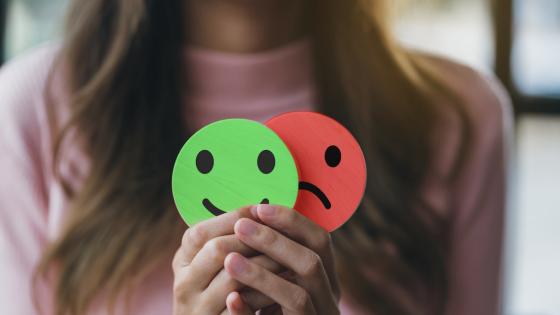Academics and policymakers alike are placing increased emphasis on subjective wellbeing (SVB) as an important indicator of how societies are doing (Helliwell et al. 2023), with some advocating setting policy with maximising happiness in mind (Layard 2011). It may be a cause for concern, therefore, if sizeable gaps exist in the wellbeing of citizens.
Evidence is emerging of a sizeable and persistent gender wellbeing gap. Across countries and time, women have worse mental health than men, regardless of the measure used. They report a higher number of bad mental health days and more restless sleep. They are also less satisfied with many aspects of life such as the economy, democracy, and public services, as well as expressing less happiness in the moment in terms of peace, calm, and cheerfulness (Blanchflower and Bryson 2023a). Women also tend to report significantly poorer health than men on self-reported health indicators (Boerma et al. 2016) and they take anti-depressants more than men (Blanchflower and Oswald 2016).
Evidence on gender differences in happiness and life satisfaction is less clear-cut, varying across time and place, with covariate adjustments (Blanchflower and Bryson 2023a), and even across months within the year (Blanchflower and Bryson 2023b). This has led to speculation about a ‘female happiness paradox’ in which women are less happy than men in negative affect equations, whereas there is ambiguity in gender differences in happiness and life satisfaction. Some go further and argue that there is a clear paradox, with women being both more depressed and more satisfied with life (Becchetti and Conzo 2022).
Diener et al. (1999) argue that a possible explanation of the paradox is that women, on average, experience both positive and negative emotions more strongly and frequently than men. So, in the general population, women's more intense positive emotions potentially balance their higher negative affect, resulting in levels of global SWB similar to those of men. Fujita et al. (1991) argue that as women are more open to emotional experience on average this may make them more vulnerable to depression, while if their lives are good, women may be more likely to experience intense levels of happiness. Even though intensely happy and intensely unhappy individuals are rare women may therefore be overrepresented in both groups. “Women may be more willing to experience and express emotions” (Diener et al 1999: 292).
The ‘paradox’ interpretation of the gender wellbeing gap has been challenged recently from two quarters. First, in Blanchflower and Bryson (2023a) we maintain that men have become happier and more satisfied with life than women since a period just before the COVID pandemic, implying women are less happy today than men, whether one uses positive or negative affect metrics to capture wellbeing. The second challenge has come from Bartram (2022), who maintains that the paradox is an artefact of analysts conditioning on ‘bad’ controls. He argues that a number of the variables that researchers tend to condition on in the wellbeing literature partial out some of the gender effects they seek to isolate. If one omits such controls, he argues, there is no significant difference in the life satisfaction of men and women, and thus no paradox.
It is also arguable from a theoretical perspective that there is no paradox because these SWB metrics are capturing different things. Diener et al. (1985) argue that positive affect and negative affect refer to affective, emotional aspects of SWB, while life satisfaction is a ‘cognitive-judgement’ aspect of SWB. Life satisfaction is based on a judgement of how content people are based on a comparison each person sets for themselves. If one recognises these differences, the question is why is it that women differ from men along these different dimensions of SWB?
In any event, despite the findings on women’s economic progress in terms of participation and wages, there is solid and consistent evidence that there continues to be a wellbeing gap. In particular, women continue to have lower levels of mental health than men, so there is a mental health gap. The evidence on positive affect – including happiness, satisfaction, enjoyment, and cheerfulness – appears contradictory.
To shed further light on this issue, we estimate gender wellbeing gaps across 50 SWB metrics – 33 positive affect (including happiness and life satisfaction) and 17 negative affect – contained in eleven surveys from 167 countries across the world (Blanchflower and Bryson 2023c). We find women score more highly than men on all 17 negative affect measures and lower than men on all but three positive affect metrics, confirming a gender wellbeing gap. The gap is apparent across countries and time and is robust to the inclusion of exogenous covariates (age, age squared, time and location fixed effects). It is also robust to conditioning on a wider set of potentially endogenous variables.
However, when one examines the three ‘global’ wellbeing metrics – happiness, life satisfaction and Cantril’s ladder – women are either similar to or ‘happier’ than men. Contrary to recent claims in the literature, this finding is insensitive to which controls are included and varies little over time. Furthermore, the relative happiness of women with respect to these global wellbeing metrics does not seem to arise from measurement or seasonality, as the variables are taken from the same surveys and frequently measured in the same way. The female happiness paradox is most apparent in the Gallup Daily Tracker and World Poll Surveys, where women are always happier and more satisfied with life than men, regardless of covariate adjustment, but also sadder, more stressed, worried and in pain, and have less enjoyment and are less likely to be well rested.
We examined several reasons as to why women have poorer mental health than men, have lower momentary wellbeing, and are less satisfied with most domains in their life, yet at the same time express higher life satisfaction and higher happiness. The female coefficient in positive affect equations is not sensitive to what time period the positive affect variable refers to: those variables that refer to life as a whole generate broadly the same answers as those asking how the respondent felt yesterday or the last week or two.
It doesn’t seem to matter much how the life satisfaction variable is coded, be it 4-step such as used in the Eurobarometer and Latinobarómetro, or 10-step or 11-step as used in, for example, the Gallup World Poll and US Daily Tracker’s 11-step (0-10) Cantril life satisfaction measure, the 11-step variables (0-10) used in the European Social Survey, or the 10-step (1-10) life satisfaction variable used in the European Quality of life Survey, the UK Annual Population Survey, the European Values Survey, or the PISA 2018 Survey. The same result is obtained in the Gallup files for a (1,0) dummy variable for happiness relating to yesterday as for the Cantril ladder variable.
A positive female coefficient is much less likely to be found in other positive affect variables such as enjoyment, calmness, cheerfulness as well as views on the economy, the education system and so on, which also are measured in a variety of ways, as well as in expectations. These are obtained from the same surveys and hence the same individuals reporting happiness and life satisfaction. This implies no female paradox. So, the female happiness paradox appears to relate only to happiness and life satisfaction variables and, even then, not in every estimate.
In contrast, the female coefficient is highly insensitive generally to changes in specification in negative affect variables, where always and everywhere the female coefficient is positive and does not depend on how the variable is measured, what time period is covered, and what the variable refers to, be it depression, loneliness, sadness, or anxiety.
It may be that women have a different set point to men in responding to global wellbeing questions compared to responses on all other positive and negative affect questions. Given the uncertainty as to why the lower wellbeing of women, apparent in all other positive and negative affect metrics, switches sign when focusing on happiness, life satisfaction and Cantril’s ladder, analysts would do well to devote greater attention to a wider set of wellbeing metrics than is currently the case.
References
Bartram, D (2022), “The ‘gender life-satisfaction/depression paradox’ is an artefact of inappropriate control variables”, Social Indicators Research 164: 1061–1072.
Becchetti, L and G Conzo (2022), “The gender life satisfaction/depression paradox”, Social Indicators Research 160(1): 35–113.
Blanchflower, D G and A Bryson (2023a), “The female happiness paradox”, Journal of Population Economics, forthcoming.
Blanchflower, D G and A Bryson (2023b), “Seasonality and the female happiness paradox", Quality and Quantity, February.
Blanchflower, D G and A Bryson (2023c), “The gender well-being gap”, NBER Working Paper No. 31212.
Blanchflower, D G and A J Oswald (2016), “Antidepressants and age: A new form of evidence for U-shaped well-being through life”, Journal of Economic Behavior & Organization 127: 46–58.
Boerma, T, A R Hosseinpoor, E Verdes and S Chatterji (2016), “A global assessment of the gender gap in self-reported health with survey data from 59 countries”, BMC Public Health 16: 675.
Diener, E, R A Emmons, R J Larsen and S Griffin (1985), “The satisfaction with life scale”, Journal of Personality Assessment 49(1): 71-75.
Diener, E, E M Suh, R E Lucas and H L Smith (1999), “Subjective well-being: Three decades of progress”, Psychological Bulletin 125(2): 276–302.
Fujita, F, E Diener and E Sandvik (1991), “Gender differences in negative affect and well-being. The case for emotional intensity”, Journal of Personality and Social Psychology 61: 427-434.
Helliwell, J F, R Layard, J D Sachs, J-E De Neve, L B Aknin and S Wang (2023), World Happiness Report, Sustainable Development Solutions Network.
Layard, R (2011), Happiness: Lessons from a New Science, Penguin.



